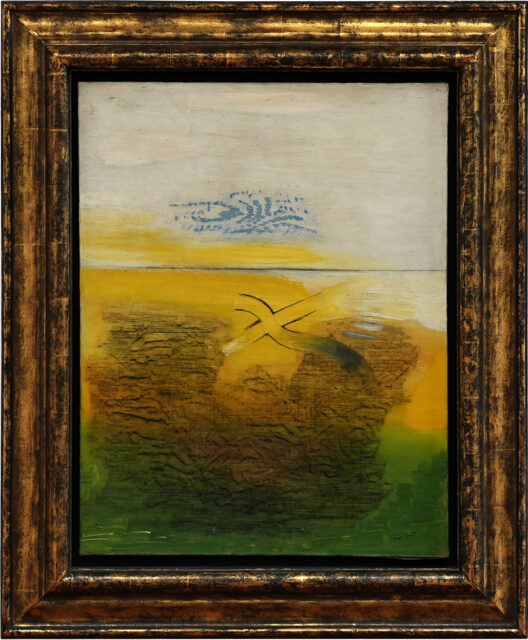Marine
Details
Spies-Metken 973.
Exhibition:
Hans Bellmer, Victor Brauner, Salvador Dali, Max Ernst, Wilfredo Lam, René Magritte, Pierre Roy, Alberto Savinio, Max Walter Svanberg, Yves Tanguy, Toyen, Galerie André François Petit, Paris 1965, with col. with colour illus;
Le Sillabe mute dell’Immaginazione, Galleria Gissi, Turin 1971, cat. no. 11, with col. Illus., stamped on the reverse on the stretcher;
Max Ernst – Yves Tanguy: Deux Vision du Surréalisme, Musée Paul Valéry, Sète 2016.
Provenance:
Walter Schwarzenberg Collection, Brussels;
Galerie Georges Giroux, Brussels 1/2 February 1932, lot 116, on the reverse on the stretcher with the label;
Galerie André François Petit, Paris;
Galleria Arturo Schwarz, Milan;
Christie’s, London 27 June 1995, lot 183;
Private collection, Monaco.
Description
– Fantastic surrealist landscape from the groundbreaking “La Mer” series
– One of the earliest “Grattage” works, a new painting technique developed by Max Ernst
– From the famous collection of the gallery owner Walter Schwarzenberg in Brussels, an important patron of the Surrealists in Belgium
During his summer holiday in Pornic, Brittany, in 1925, Max Ernst was inspired to create the series “La Mer”, which is steeped in maritime aesthetics and includes the painting “Marine”.
Ernst, who rejected conventional painting techniques and traditional iconography, invented his very own technique of frottage or grattage that summer, which influenced his overall artistic oeuvre from then on. Frottage is a rubbing technique used to transfer wood grain or leaf structures onto paper. Ernst had already used frottage before, but not yet as an independent technique. “The washed-out wooden floor in a small hotel in Pornic on the Atlantic coast suggested to him a texturally rich, interpretable source world. He laid paper on the floorboards and rubbed the underlying structures with soft graphite. Thanks to the combination of the most diverse, relief-like, perceptible textures, he enriched this wealth of forms and, interpreting them, transformed them into precise drawings. The elements used include boards, straw wickerwork, hard bread, twine, cherry stalks, leaves and bark. Here, too, the reuse of the individual structures leads to standardisation. There is an exchange of graphic elements from sheet to sheet.” (Werner Spies, Max Ernst. Werke 1925-1929, Cologne 1976, p. VII). In Grattage, Ernst adapted this process for oil painting by placing a canvas painted with thin layers of colour on a textured surface and scratching away the paint to create rich patterns: The material of the painting ground becomes visible and suggests completely new forms. In this way, Max Ernst creates predominantly highly abstracted fantastic landscapes that suggest the sun, waves, horizon, day and night with just a few shapes, lines and colours. Grattage remained an integral part of Ernst’s creative process for decades, serving as a creative technique that enabled him to overcome his fear of blank paper or empty canvas.
The painting comes from the former estate of Walter Schwarzenberg, owner of the Le Centaure gallery in Brussels. He promoted many contemporary expressionist and surrealist artists, in particular René Magritte. However, the gallery’s financial success failed to materialise and Schwarzenberg was forced to close the gallery in 1930. In 1932, his extensive collection of 360 works by modern French, German and Belgian artists was auctioned off at the Galerie Georges Giroux. The Max Ernst painting “Marine” was also sold at this auction.
* All results incl. buyer’s premium (27%) without VAT. No guarantee, subject to error.
** All post-auction prices excl. buyer's premium and VAT. No guarantee, subject to error.
*** Conditional Sale: The bid was accepted below the limit. Acquisition of the work may still be possible in our post-auction sale.
R = regular taxation
N = differential taxation on works of art which originate from a country outside of the EU
The private or commercial use of images shown on this Website, in particular through duplication or dissemination, is not permitted. All rights reserved.






